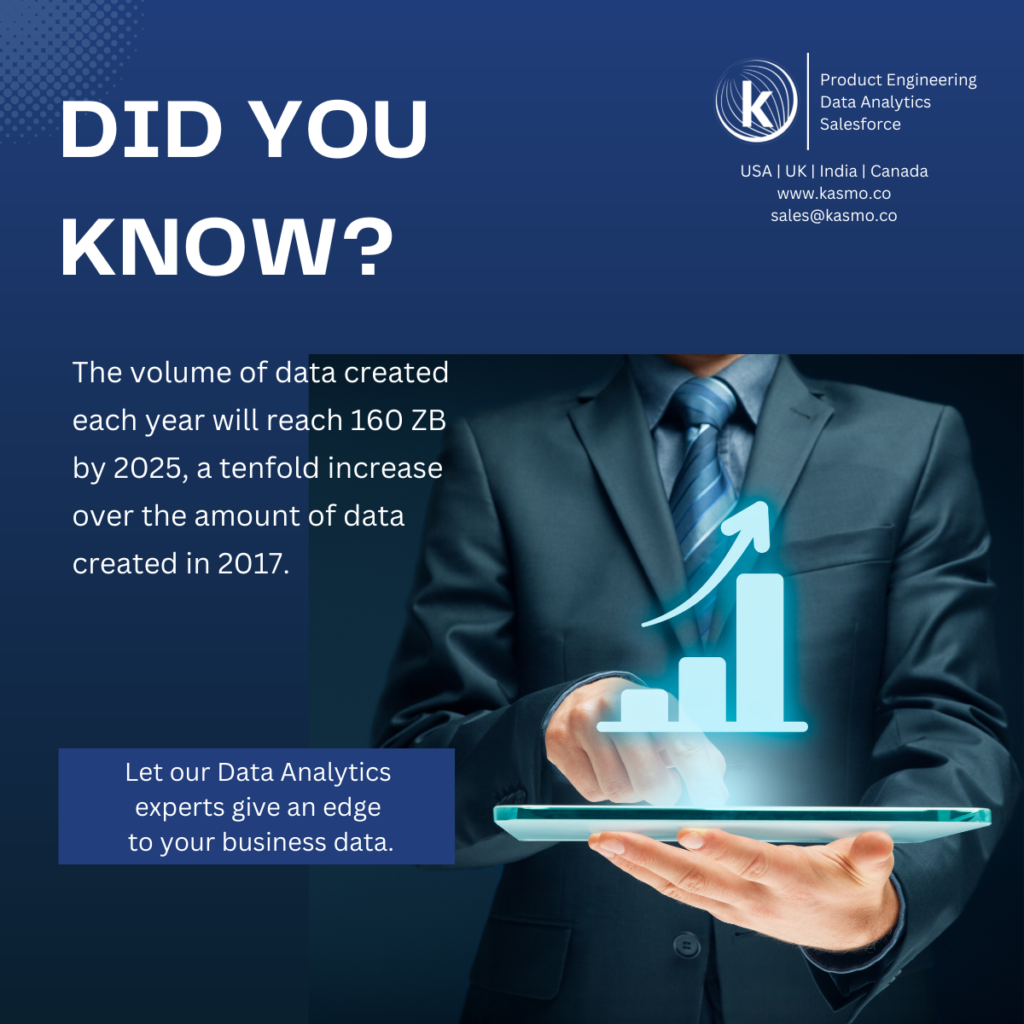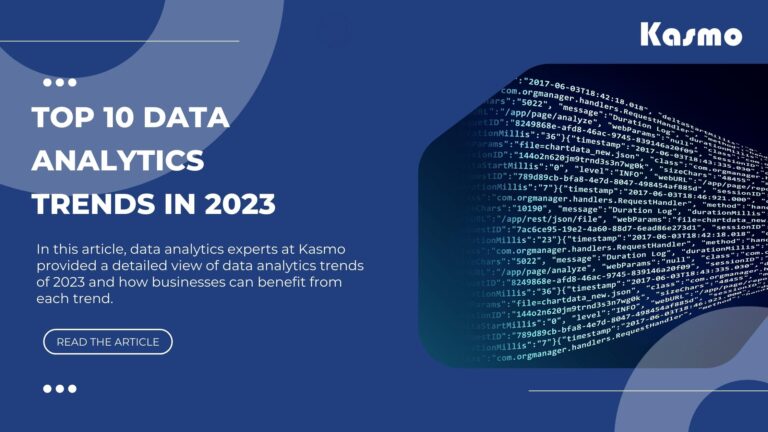With customer touchpoints diversifying with technology, capturing data emanating from various sources and filtering the insights turns through data analytics indispensable for businesses. The evolution of data analytics helps discover a broader spectrum of insights for profitable business decision-making. Knowledge of data analytics trends helps businesses to stay agile, make fast-paced business decisions and increase the effectiveness of processes.
It’s no surprise that business decisions today are data-driven. Relying on data insights is a proven strategy to make business decisions that click amidst the challenging business landscape. In this article, data analytics experts at Kasmo provided a detailed view of data analytics trends of 2023 and beyond and how businesses can benefit from each trend. Move ahead in the article to know more.
1. Explainable Artificial Intelligence
Artificial intelligence has always piqued human curiosity for both good and not-so-good reasons. While AI supporters claimed that artificial intelligence would open up unforeseen possibilities for humankind, their counterparts insisted that AI may deprive humans of their jobs and livelihood.
Irrespective of the debate surrounding it, artificial intelligence is slowly pervading our lives in various areas. From incorporating AI into lifestyle to making complex, software codes with AI, we are already witnessing the AI possibilities.
However, the secrecy of how AI works has always remained. Most AI applications and models appear to be black boxes even today. With data analytics, we may finally comprehend this secret behind AI decision-making.
Data Analytics trends – AI Takeaway:
Experts foresee a future where data analytics will make AI more transparent. Users can ‘see’ how an AI-driven application is making its decision. Hello there, Explainable Artificial Intelligence (XAI).
2. Edge Computing
Edge computing redefines how fast the data flows in the internet of things (IoT) loop from the source to the user and back. In edge computing, the computing locations are closer to the user. It results in enhanced user experiences and faster processing time. Edge computing benefits sensitive applications that require good latency and speed.
Similarly, businesses that leverage edge computing can provide services to more users by scaling up the centralized infrastructure and efficiently utilizing the available resources.
Data analytics and edge computing will fast pace the data processing speed exponentially. The result is more powerful, agile, and faster IoT devices capable of performing real-time analytics and displaying autonomous behavior.
Data Analytics trends – Edge computing Takeaway:
The future where we can process massive amounts of data from remote locations at reduced costs is fast approaching, thanks to data analytics and edge computing.
3. Augmented Analytics
Augmented analytics plays a vital role in insight generation and explanation to supplement how people explore and analyze data in analytics and BI platforms. Unlike automation, augmented analytics uncovers hidden insights and helps users to reap their benefits.
Similarly, businesses can save on resources using augmented analytics. Data handling, value extraction, and decision-making are all accelerated with the help of augmented analytics without the necessity of additional resources. Data experts can benefit from the time-saving augmented analytics offers while processing data preparation tasks and advanced data analysis.
Data analytics trends – Augmented Analytics Takeaway:
Augmented analytics transforms data analytics tasks faster, more cost-effective, and more efficiently. Both businesses and users can benefit from the agility and speed of insights Augmented analytics presents.
4. Data Fabric
A data fabric is a dynamic architecture that standardizes and adds consistency to the data capabilities, practicalities, and practices across all touch points – cloud, on-premises, and edge devices. Data visibility, access, protection, and security turn simpler and more robust with data fabric.
Data fabric adds more transparency to the data processes and roles. Businesses can supervise end-to-end monitoring, storage, performance, and efficiency through this unified platform. Data fabric also reduces operational costs and data handling siloes.
Businesses can eliminate their disconnected infrastructure, data, and efficiency loss through data fabric. They can maximize the utilization of cloud, core, and edge devices while centrally governing them all.
Data analytics trends – Data Fabric Takeaway:
A data fabric is a strategic approach that reduces tedious data management and enhances testing and deployment speed while assuring 24×7 data security.
5. Data Democratization
As popularly quoted, “Data is the new currency, and it’s the medium of exchange between consumers and marketers.” No wonder companies embrace data democratization to produce better outcomes across all teams. Democratizing data is a way to empower employees to make effective data-driven decisions.
In organizations where data democratization is in place, all departments could make data-driven decisions. For instance, marketing teams can create effective campaigns with free data access, while sales teams can provide better customer experiences.
Data analytics is thus reaching every employee across the organization through data democratization. Hence, businesses with data analytics tools and processes to democratize data gain an edge in decision-making and customer experience.
Data analytics trends – Data Democratization Takeaway:
Investing in a data warehousing solution like Snowflake helps data availability, analysis, and downstream action.

6. Data-as-a-Service
Imagine a scenario where you can deliver applications over the cloud rather than over the network. Data as a Service realizes such possibilities eliminating the n-premises data storage, processing, and integration costs.
Data as a Service eases data sharing across the teams, speed up business review tasks, saves infrastructure set-up time, improves scaling flexibility, and automates maintenance. As the DaaS provider handles the end-to-end data tool set-up and management, additional costs and resources follow.
DaaS in data analytics has witnessed more demand, especially post-pandemic. The Healthcare industry, for instance, is one of its biggest benefactors. As data analytics rapidly finds its place across all aspects of life, DaaS will soon revolutionize how businesses utilize data.
Data analytics trends – Data-as-a-Service Takeaway:
DaaS is a crucial step for the cloud-first vision of companies. As we progress into a data-centric future, more and more businesses will adopt DaaS.
7. NLP and Conversational Analytics
Conversational analytics is an advanced AI technology where machines understand and process human language in written and spoken language. It helps elevate the customer experience, empowers marketing teams to diversify their efforts, and optimizes marketing campaigns.
Natural Language Processing, NLP, analyses a language for its meaning. It finds immense applications in text mining, machine translation, and automatic question answering owing to its features such as sentiment analysis, topic extraction, and relationship extraction.
Together, conversational analytics and NLP can impart more power to data analytics.
Conserves time and effort in manually searching for records.
- Eliminate manual errors in text and voice recording and analyzing.
- Assist in spreading awareness about natural disasters by identifying predetermined regions using AI.
- Empower individuals to understand technology irrespective of their technical know-how.
- Enable people with speech and accent disabilities to communicate better with the help of technology.
- Improve business intelligence through the effective use of market research and social media data.
Data analytics trends – NLP and Conversational Analytics Takeaway:
Data analytics is all set to transform human experience language and text. It can reveal many wondrous innovations that assist the disabled, save time, and help in causes like environmental protection and disaster management.
8. Data Analytics Automation
Automation of data analytics increases the speed of end-to-end data access, handling, and management. From data preparation to report generation, data analytics automation increases the transparency and data access to all users involved with enhanced security.
The AI/ML techniques in data analytics automation enable users to monitor massive data sets, obtain faster insights, and enable effective decision-making. By blending the power of data analytics and automation, businesses can realize diverse high-value use cases that would otherwise appear complex, costly, and resource-intensive.
Data analytics trends – Data Analytics Automation Takeaway:
Data analytics automation realizes simplified, speedy, and automated data preparation and insight gathering allowing effective handling of massive volumes of data.
9. Data Governance
Amidst the digital revolution, businesses experience a heavy data influx from disparate sources – social media, smart devices, emails, the web, and more. Thus, data democratization and data security are two diverse critical challenges amidst stringent global compliance regulations.
According to Gartner, 65% of the global population will be governed by some compliance regulation by 2023. It explains why data governance is an immediate priority for businesses.
Governance suggests that data management in organizations must assure transparency in data collection, type, and purpose of data. Data governance thus aims at developing data products and services that provide data security assurance to users.
Data analytics trends – Data Governance Takeaway:
The near future can bring more regulations such as GDPR, PIPL, and PIPEDA, which will protect user data, empowering users to experience the data analytics revolution with minimal privacy concerns.
10. In-memory computing
For data-driven organizations, data storage can account for the demand for huge costs, infrastructure, and resources. In memory, computing offers a cost-effective solution to real-time data scaling.
Organizations can address their complex data requirements, including real-time regulatory compliance, omnichannel marketing, and digital transformation through in-memory computing.
Data analytics trends – In-memory computing Takeaway:
The growth of in-memory computing has been steady in the recent past. However, the future of data analytics can comprise the more prominent role of in-memory computing for its robust effectiveness in facilitating high-value business activities.
Summing Up
As Chris Lynch puts it, “Big data is at the foundation of all of the megatrends that are happening today, from social to mobile to the cloud to gaming.” As we move closer to an AI-driven future, businesses – large, medium, and small- must adapt to the digital transformation where data analytics will play a pivotal role. These data analytics trends will further revolutionize how businesses benefit from the data, user experience, and data security.
Connect with Kasmo experts to leverage the power of data analytics to make empowered data-driven decision-making and strategically achieve your business goals. Send a message to us to schedule a free demo.

